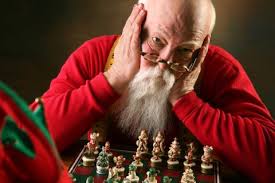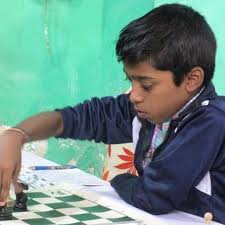Father Christmas popped into the club for a game of chess on Monday but he clearly wasn’t happy with the set he had to play with as you can see. However, he did suggest a few questions for the annual Broadstairs Christmas Dinner next Monday but I thought it best to advertise the quiz now. It’s a mixture of the fiendishly difficult, the trivial and the downright silly. (As I write this, not all questions have not been set so I hope they live down to the billing.) I am confident that no-one will get them all right so I am offering free entry to the 2018 Thanet Chess Congress to the first correct entry received by December 31st. Results will appear in the New Year.
- Here’s a tricky one to start with. In this position both players have played four moves and White was checkmated after Black’s fourth but only White’s position is shown. He must have learnt from me as his moves were as follows: f3, Kf2, Kg3 Kh4. The question is…..what moves did Black make in order to ensure mate on move 4?
- A British Museum record of December 8 1832 states that ’67 chessmen carved about the 13th century from the teeth of the walrus, found in………’ Where?
- In which 17th century play was a game of chess first shown on stage?
- What do these four winners of the tournaments in brackets have in common: Emanuel Lasker (New York 1893), Henry Atkins (Amsterdam 1899), Jose Raul Capablanca (New York 1913), Bobby Fischer (New York 1963/64)?
- Where can you find a chess board that belonged to Charles I with these words inscribed around the edge: ‘With these, subject and ruler strive without bloodshed’?
- According to the Polish/French Grandmaster, Savielly Tartakover, there are four types of chess player. What are they?
- Here’s an easy one: in which year was Broadstairs Chess Club founded?
- Who said ‘Chess…is a foolish experiment for making idle people believe they are doing something very clever’?
- Whose first attendance at a chess tournament in Moscow is amusingly described here: “In front of a good-sized theatre….there was an unusually long line of people ….It had to be something sensational with this many people waiting for a chance to get in….I had apparently come in during the intermission yet the curtain was raised and the stage was lit….Then a buzzer sounded and people damn near trampled each other to get back to their seats. A boy, maybe ten or twelve, walks out from the wings. He moves one of the props on the table. The joint is so quiet I can hear my wristwatch ticking. A guy comes out, walks to the footlights, announces something to the audience and the joint goes wild….This is absolutely the craziest show I ever saw.”
- Finally, in a neat symmetry, let’s finish with another puzzle. White to play and mate in two moves.


